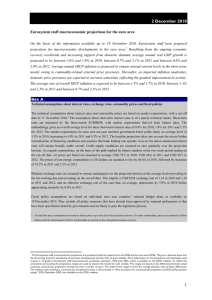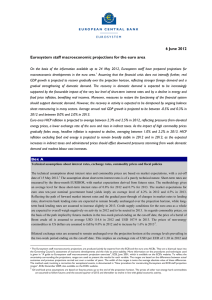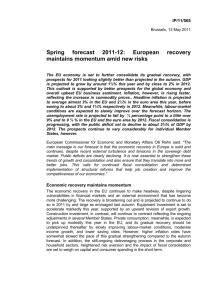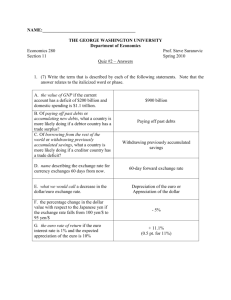6 December 2012 Eurosystem staff macroeconomic projections for the euro area
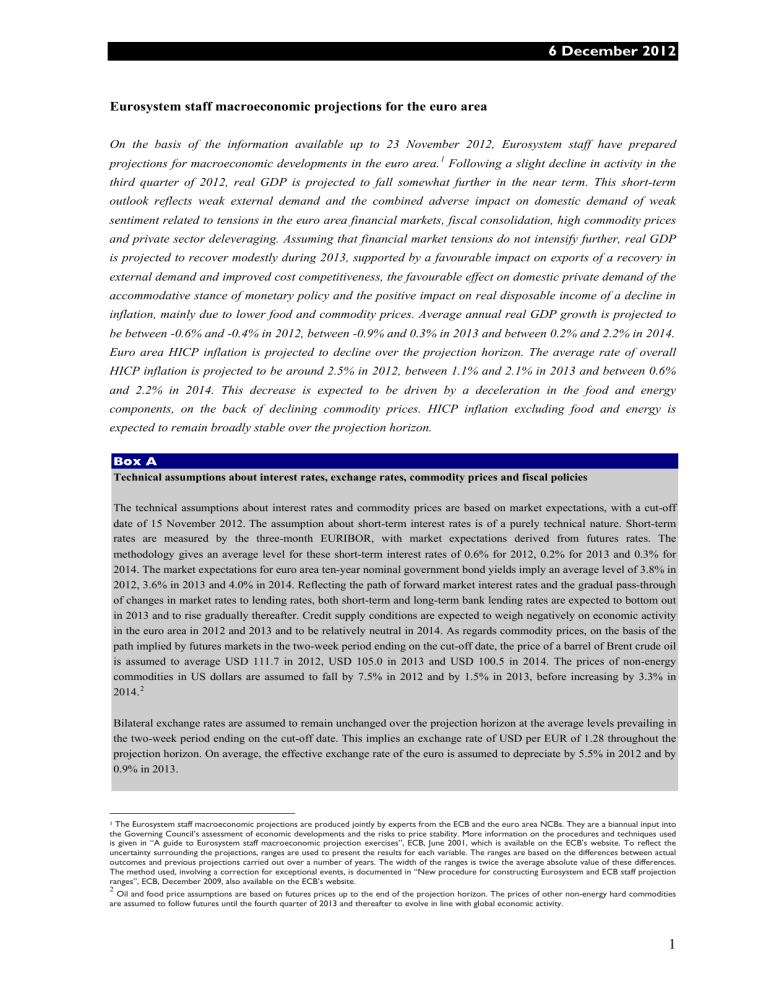
6 December 2012
Eurosystem staff macroeconomic projections for the euro area
On the basis of the information available up to 23 November 2012, Eurosystem staff have prepared projections for macroeconomic developments in the euro area.
Following a slight decline in activity in the third quarter of 2012, real GDP is projected to fall somewhat further in the near term. This short-term outlook reflects weak external demand and the combined adverse impact on domestic demand of weak sentiment related to tensions in the euro area financial markets, fiscal consolidation, high commodity prices and private sector deleveraging. Assuming that financial market tensions do not intensify further, real GDP is projected to recover modestly during 2013, supported by a favourable impact on exports of a recovery in external demand and improved cost competitiveness, the favourable effect on domestic private demand of the accommodative stance of monetary policy and the positive impact on real disposable income of a decline in inflation, mainly due to lower food and commodity prices. Average annual real GDP growth is projected to be between -0.6% and -0.4% in 2012, between -0.9% and 0.3% in 2013 and between 0.2% and 2.2% in 2014.
Euro area HICP inflation is projected to decline over the projection horizon. The average rate of overall
HICP inflation is projected to be around 2.5% in 2012, between 1.1% and 2.1% in 2013 and between 0.6% and 2.2% in 2014. This decrease is expected to be driven by a deceleration in the food and energy components, on the back of declining commodity prices. HICP inflation excluding food and energy is expected to remain broadly stable over the projection horizon.
Box A
Technical assumptions about interest rates, exchange rates, commodity prices and fiscal policies
The technical assumptions about interest rates and commodity prices are based on market expectations, with a cut-off date of 15 November 2012.
The assumption about short-term interest rates is of a purely technical nature. Short-term rates are measured by the three-month EURIBOR, with market expectations derived from futures rates. The methodology gives an average level for these short-term interest rates of 0.6% for 2012, 0.2% for 2013 and 0.3% for
2014. The market expectations for euro area ten-year nominal government bond yields imply an average level of 3.8% in
2012, 3.6% in 2013 and 4.0% in 2014. Reflecting the path of forward market interest rates and the gradual pass-through of changes in market rates to lending rates, both short-term and long-term bank lending rates are expected to bottom out in 2013 and to rise gradually thereafter. Credit supply conditions are expected to weigh negatively on economic activity in the euro area in 2012 and 2013 and to be relatively neutral in 2014. As regards commodity prices, on the basis of the path implied by futures markets in the two-week period ending on the cut-off date, the price of a barrel of Brent crude oil is assumed to average USD 111.7 in 2012, USD 105.0 in 2013 and USD 100.5 in 2014. The prices of non-energy commodities in US dollars are assumed to fall by 7.5% in 2012 and by 1.5% in 2013, before increasing by 3.3% in
2014.
Bilateral exchange rates are assumed to remain unchanged over the projection horizon at the average levels prevailing in the two-week period ending on the cut-off date. This implies an exchange rate of USD per EUR of 1.28 throughout the projection horizon. On average, the effective exchange rate of the euro is assumed to depreciate by 5.5% in 2012 and by
0.9% in 2013.
1 The Eurosystem staff macroeconomic projections are produced jointly by experts from the ECB and the euro area NCBs. They are a biannual input into the Governing Council’s assessment of economic developments and the risks to price stability. More information on the procedures and techniques used is given in “A guide to Eurosystem staff macroeconomic projection exercises”, ECB, June 2001, which is available on the ECB’s website. To reflect the uncertainty surrounding the projections, ranges are used to present the results for each variable. The ranges are based on the differences between actual outcomes and previous projections carried out over a number of years. The width of the ranges is twice the average absolute value of these differences.
The method used, involving a correction for exceptional events, is documented in “New procedure for constructing Eurosystem and ECB staff projection ranges”, ECB, December 2009, also available on the ECB’s website.
2 Oil and food price assumptions are based on futures prices up to the end of the projection horizon. The prices of other non-energy hard commodities are assumed to follow futures until the fourth quarter of 2013 and thereafter to evolve in line with global economic activity.
1
6 December 2012
Fiscal policy assumptions are based on individual euro area countries’ national budget plans that were available on
23 November 2012. They include all policy measures that have already been approved by national parliaments or that have been specified in detail by governments and are likely to pass the legislative process.
The international environment
World real GDP growth (excluding the euro area) is projected to pick up gradually, rising from 3.7% in
2012 to 3.8% in 2013 and to 4.5% in 2014. Following a dip in the growth momentum in the second quarter of 2012, recent GDP data in some regions point to a modest pick-up in global economic activity towards the end of the year. Over the medium term, the pace of growth in the world economy is expected to be dampened by limited sectoral rebalancing in the advanced economies and the need to repair further both public and private sector balance sheets in these economies. Despite progress in some areas, particularly in the US housing market, debt levels remain elevated in a number of major advanced economies. In emerging markets, growth has moderated following weaker external demand and the effects of past policy tightening.
A loosening of monetary policy in recent months, coupled with fiscal stimulus measures in some countries and improved financial conditions, is expected to support a gradual recovery in growth in the emerging economies. World trade is assumed to be weak in the short term and to pick up gradually over the course of next year. In terms of annual growth rates, euro area foreign demand is estimated to grow by 3.4% in
2012, by 3.7% in 2013 and by 6.8% in 2014.
Real GDP growth projections
Euro area real GDP fell by 0.1% in the third quarter of 2012, having declined by 0.2% in the previous quarter and stagnated in the first quarter. Domestic demand declined during the first three quarters of
2012. Private consumption was depressed, reflecting the weakness in real disposable income. Moreover, fragile consumer sentiment, in the context of tensions in the euro area financial markets and rising unemployment, appears to have prevented more intense consumption smoothing. Low and falling capacity utilisation, worsening demand prospects, heightened uncertainty and adverse credit supply conditions in some countries have depressed business investment. Net exports contributed positively to growth in the first three quarters of 2012, albeit mostly due to the weakness of import growth. Owing to the continued adverse impact of these factors, real GDP is expected to fall further in the near term.
Looking further ahead, assuming that the financial market tensions do not intensify further, euro area real
GDP is expected to stabilise in the first half of next year and recover gradually thereafter. In 2013, a gradual pick-up in export growth, supported by external demand developments and improved competitiveness, is likely to provide a positive contribution to real GDP growth, as imports will remain subdued in the context of weak overall demand. The recovery is also expected to be supported by a favourable impact on domestic private demand of the accommodative monetary policy stance and by the favourable impact on real disposable income of a decline in inflation driven by lower food and commodity prices. However, the adverse impact on domestic demand of heightened uncertainty, fiscal consolidation and remaining deleveraging needs in some countries is expected to diminish only gradually over the projection horizon.
2
6 December 2012
Overall, the projected recovery is expected to remain subdued by historical standards. In annual average terms, euro area real GDP is expected to grow by between -0.6% and -0.4% in 2012, between -0.9% and
0.3% in 2013 and between 0.2% and 2.2% in 2014.
In more detail, extra-euro area export growth is projected to be weak during the second half of 2012 and to strengthen thereafter, reflecting the gradual strengthening of external demand. After a recent pick-up, euro area export market shares are projected to decline somewhat in 2013 and 2014, resuming their longterm downward trend. Intra-euro area exports are projected to grow far more slowly than extra-euro area exports, owing to the relative weakness of domestic demand within the euro area.
Euro area non-residential private investment is expected to decline strongly in the near term, owing to heightened uncertainty, weak business sentiment, low capacity utilisation, poor demand prospects and adverse credit supply conditions in some countries. It is projected to pick up later in the projection horizon, supported by a strengthening in domestic and external demand, the very low level of interest rates and improving profit mark-ups. Ongoing balance sheet restructuring, uncertainty in view of tensions in the euro area financial markets and adverse financial conditions in some euro area countries are likely to continue to dampen the projected recovery of business investment over the projection horizon. Residential investment is expected to decline throughout the projection horizon, owing to weak disposable income growth, fragile consumer sentiment and, possibly, further adjustments in the housing markets in some countries. These adverse impacts are expected to more than offset the relative attractiveness of housing investment in some other countries, where residential investment is supported by historically low mortgage rates. Government investment is expected to decline up to the end of 2014, driven by fiscal consolidation packages in several euro area countries.
Table 1 Macroeconomic projections for the euro area
(average annual percentage changes) 1)
2011 2012 2013 2014
HICP 2)
Real GDP
Private consumption
Government consumption
Gross fixed capital formation
Exports (goods and services)
2.7
1.5
0.1
-0.2
1.6
6.5
2.5 – 2.5
-0.6 – -0.4
-1.2 – -1.0
-0.6 – 0.2
-4.2 – -3.4
2.1 – 3.7
1.1 – 2.1
-0.9 – 0.3
-1.1 – -0.1
-1.2 – 0.0
-4.2 – -1.0
-0.4 – 5.0
0.6 – 2.2
0.2 – 2.2
-0.4 – 1.4
-0.4 – 1.2
-1.0 – 3.6
2.0 – 8.6
Imports (goods and services) 4.3 -1.1 – 0.3 -1.7 – 3.7 1.7 – 7.7
1) The projections for real GDP and its components refer to working day-adjusted data. The projections for imports and exports include intra-euro area trade.
2) The reported zero range for 2012 is due to rounding.
Private consumption is projected to decline further in the near term. This reflects a sharp decrease in real disposable income, only partly offset by a temporary steep decline in the saving ratio as households try to smooth consumption. The weakness in real disposable income reflects a steep fall in employment and a rise in consumer prices beyond that of nominal compensation per employee, fiscal consolidation measures in
3
6 December 2012 some euro area countries and weak non-labour income. Private consumption is expected to stabilise during the course of 2013, reflecting a moderate recovery of real disposable income, as the adverse impacts of fiscal consolidation and cuts in employment gradually fade and a decline in commodity price pressures benefits real incomes. In 2014, private consumption growth will recover moderately, owing to a pick-up in labour income as labour market conditions improve. However, a gradual rise in the saving ratio starting in early 2013 – reflecting the weak labour market situation and an unwinding of households’ former consumption smoothing behaviour – is expected to dampen the recovery of private consumption.
Government consumption is projected to decline in 2012 and 2013, owing to fiscal consolidation efforts, and to increase modestly in 2014.
Extra-euro area imports are expected to have weakened in the second half of this year and to rebound in the course of 2013, albeit still constrained by weak total demand. Reflecting a stronger growth in exports accompanied by weak import developments, net trade is expected to contribute positively to GDP growth over the projection horizon.
Weak activity developments in the last few years are expected to have adversely affected potential growth, although the exact magnitude of the impact remains highly uncertain. It is likely that the continued weakness in employment and investment will further weigh on potential output growth. Given the weak outlook for real GDP growth, the negative output gap is projected to widen in 2012 and 2013, before narrowing somewhat in 2014.
Price and cost projections
Overall HICP inflation is projected to decline from an average rate of around 2.5% in 2012 to between 1.1% and 2.1% in 2013 and between 0.6% and 2.2% in 2014. The fall in inflation in 2013 primarily reflects the projected strong decline in energy price inflation and, to a lesser extent, food price inflation. The drop in energy price inflation is mostly due to the expected fading away of the impact of past increases in oil prices and an assumed gradual decline in oil prices over the projection horizon. Similarly, the decline in food price inflation reflects the assumption that international and European food commodity prices ease somewhat over the projection horizon, while the impact of their recent increases fades away. By contrast, HICP inflation excluding food and energy is projected to remain broadly stable. The apparent absence of cyclical behaviour of this inflation measure reflects diverse developments in the underlying factors. In 2012 and
2013, increases in indirect taxes and administered prices are expected to exert upward pressures on underlying inflation, offsetting downward pressures stemming from weak domestic demand. In 2014, the impact of tax increases is assumed to be small – partly reflecting the fact that little information for that year is currently available – while a gradually closing output gap, owing to a pick-up in activity, should restrain to a lesser extent price increases.
External price pressures have strengthened somewhat in recent months, on the back of increases in oil and food commodity prices. As commodity prices are assumed to decline over the projection horizon, the average annual rate of change of the import deflator is projected to decline strongly in 2013 and again in
2014. Turning to domestic price pressures, the annual growth rate in compensation per employee is
4
6 December 2012 expected to be broadly stable in 2013 and 2014. Unit labour cost growth is projected to pick up this year and remain high in 2013, as wages increase more than productivity, while in 2014 it is expected to drop due to a cyclical rise in productivity. Profit margins are expected to fall in 2012 and again in 2013, buffering the stronger increases in unit labour costs in an environment of weak demand. Thereafter, falling unit labour costs and improving economic conditions are expected to support a recovery in profit margins.
Comparison with the September 2012 projections
Compared with the ECB staff macroeconomic projections published in the September 2012 issue of the
Monthly Bulletin, the upper end of the range of the real GDP growth projection for 2012 has been revised downwards to reflect a weaker short-term outlook. The range of the real GDP growth projection for 2013 has also shifted downwards, reflecting the impact on domestic demand of additional fiscal consolidation efforts in some euro area countries and the adverse impact on export growth of lower foreign demand. In addition, the projection entails a more adverse assessment of the impact of heightened uncertainty related to tensions in the euro area financial markets on domestic demand and, in particular, on fixed capital formation. With regard to HICP inflation, there is a narrowing of the projection range for 2012 and a downward revision for 2013. This reflects the past appreciation of the euro and lower oil prices in US dollars.
Table 2 Comparison with the September 2012 projections
(average annual percentage changes)
2012 2013
Real GDP – September 2012
Real GDP – December 2012
HICP – September 2012
HICP – December 2012
-0.6 – -0.2
-0.6 – -0.4
2.4 – 2.6
2.5 – 2.5
-0.4 – 1.4
-0.9 – 0.3
1.3 – 2.5
1.1 – 2.1
Box B
Forecasts by other institutions
A number of forecasts for the euro area are available from both international organisations and private sector institutions.
However, these forecasts are not strictly comparable with one another or with the Eurosystem staff macroeconomic projections, as they were finalised at different points in time. Additionally, they use different (partly unspecified) methods to derive assumptions for fiscal, financial and external variables, including oil and other commodity prices.
Finally, there are differences in working day adjustment methods across different forecasts (see the table below).
In the forecasts currently available from other institutions, euro area real GDP is expected to decline by between 0.4% and 0.5% in 2012, which is within the range of the Eurosystem staff projections. In 2013, real GDP growth is projected to be between -0.1% and +0.3%, which is within the upper half of the range of the Eurosystem staff projections. For
2014, real GDP is projected to increase by between 1.2% and 1.4%, which is within the range of the Eurosystem staff projections.
5
6 December 2012
As regards inflation, the forecasts from other institutions point to an average annual HICP inflation of between 2.3% and
2.5% in 2012, which is somewhat below the Eurosystem staff projections. In 2013 and 2014, HICP inflation is expected to average between 1.6% and 1.9% and between 1.2% and 1.9% respectively, which, for both years, is within the
Eurosystem staff projection ranges.
Comparison of forecasts for euro area real GDP growth and HICP inflation
(average annual percentage changes)
Date of release HICP inflation
IMF
Survey of Professional
Forecasters
Consensus Economics
Forecasts
Euro Zone Barometer
OECD
October 2012
November 2012 -0.5
November 2012
2012
-0.4
-0.5
November 2012 -0.5
November 2012 -0.4
GDP growth
2013
0.2
0.3
0.0
0.1
-0.1
2014
1.2
1.3
1.2
1.3
1.3
2012
2.3
2.5
2.5
2.5
2.4
2013
1.6
1.9
1.9
1.9
1.6
2014
1.4
1.9
1.7
1.9
1.2
European Commission November 2012 -0.4 0.1 1.4 2.5 1.8 1.6
Eurosystem staff projections December 2012 -0.6 – -0.4 -0.9 – 0.3 0.2 – 2.2 2.5 – 2.5 1.1 – 2.1 0.6 – 2.2
Sources: European Commission Economic Forecasts, Autumn 2012; IMF World Economic Outlook, October 2012;
OECD Economic Outlook, November 2012; Consensus Economics Forecasts; MJEconomics; and the ECB’s Survey of
Professional Forecasters.
Notes: The Eurosystem staff macroeconomic projections and the OECD forecasts both report working day-adjusted annual growth rates, whereas the European Commission and the IMF report annual growth rates that are not adjusted for the number of working days per annum. Other forecasts do not specify whether they report working day-adjusted or nonworking day-adjusted data.
6
